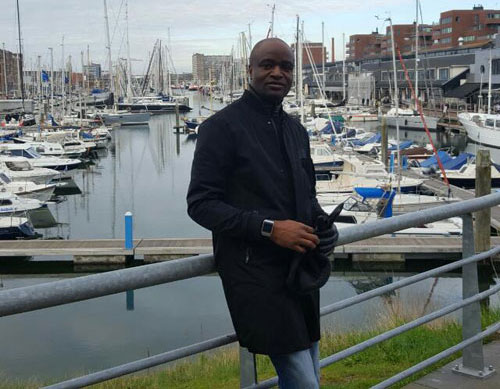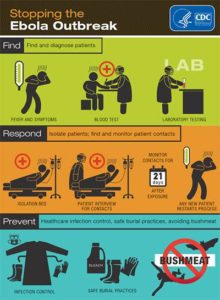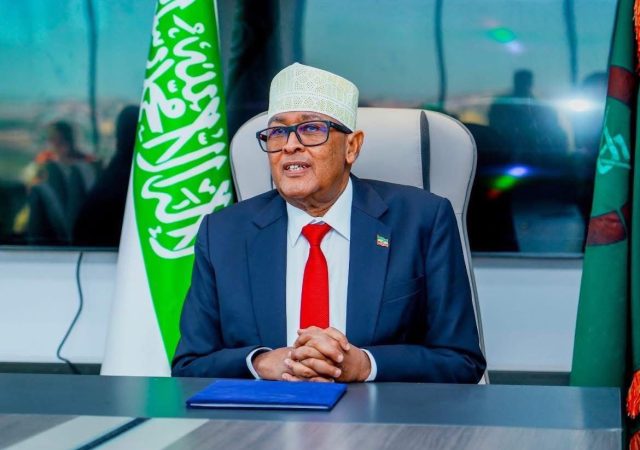
In early May (2017), Ebola resurfaced, this time in the Democratic Republic of Congo (DRC) where it was first reported in the mid-1970s. This also marked the eighth time it has been officially reported in that country. And like in previous situations, first casualties appear relatively insignificant in scale, just four deaths, which makes it easy to overlook. In the DRC, malaria is the principal cause of morbidity and mortality, accounting for more than 40 percent of all outpatient visits and for 19% of deaths among children under five years of age according to the President’s Malaria Initiative (PMI). But the stealth and zeal with which Ebola strikes, as well as its impact makes it necessary to revisit the latest re-emergence of the pandemic, its potential impact on regional health management, Nigeria, and the world in general.
Not so long ago when Ebola struck Western Africa, the Centers for Disease Control and Prevention (CDC) indicated that: “as of February 28, 2016, there were 28,639 suspected, probable, and confirmed cases of Ebola and 11,316 deaths from Ebola” in the backdrop of the epidemic that began in 2014” in West Africa. This is staggering when compared to “2,427 reported cases and 1,597 deaths in all other known cases and outbreaks of Ebola combined.” On the sub-regional economy, the World Bank also estimated that $2.2 billion was lost in Guinea, Liberia and Sierra Leone in the fiscal year 2015, in the Mano River Union area that had struggled with economic productivity in pre-Ebola times. As if that was not enough, “healthcare workers caring for patients with Ebola were among those at highest risk for contracting the disease.” The CDC estimated that “Liberia lost 8% of its doctors, nurses, and midwives to Ebola; Sierra Leone and Guinea lost 7% and 1% of their healthcare workers, respectively” to Ebola. The epidemic negatively affected the provision of healthcare services and caused setbacks in the treatment and control of other disease conditions such as HIV, tuberculosis, and malaria.
Thus on May 26, 2017, in the backdrop of trickling news of Ebola coming up again in the DRC, it was reported in online dailies (Vanguard, Leadership) that the Federal and Lagos State Governments are seeking sanctions against Kenya Airways for conveying a corpse from the DRC without necessary approval. Laboratory tests conducted on the body in Nigeria has since confirmed that the cause of death was not Ebola Virus Disease (EVD). Nigeria’s fingers had been burnt in 2014 when EVD entered the country by air from Liberia. There is need to be vigilant as Nigeria’s health care delivery system is still under stress and might burst in the event of another EVD onslaught.
In a wider perspective, a World Bank report released in the third week of May (2017), trillions of dollars (a significant proportion of global GDP) could be lost on the Earth if pandemics are not contained. Ironically, the costs of containing these types of diseases at the epidemic level before they become pandemics is estimated at just about one dollar per person per year (World Bank Report May 2017).
In the absence of immediate funds and a not-so-strong health system, then there is a need to revisit how Nigeria overcame the 2014 EVD experience and draw from its lessons as Ebola slowly rears its head in the DRC. It examined & highlighted the West African dimension of response to containing the spread of the disease. Since the EVD knows no geographical boundary, nipping it in the bud is essential, information is key. In the next section, West African Ebola situation is re-examined
Ebola virus: current realities and myths (2014)
By
Akinyinka Akinyoade and Bisola Adebayo
http://www.ascleiden.nl/news/ebola-virus-current-realities-and-myths
At the end of September 2014, twenty-four hours after the US government cautioned the Nigerian government not to be hasty in declaring the West African country Ebola-free, the US discovered Ebola victims on its own shores in Texas. This source of Ebola in the US was not from the mediatized deliberate airlifting of victims from ground-zero of the epidemic in Sierra Leone, 7000km away, to Atlanta and Charlotte (USA) for treatment in high-class medical facility, as was done last August. This time it was a man, Mr. T. Duncan, who returned home after visiting Liberia to the warm embrace of his family in Texas. Within another twenty-four hours, more than eighty persons who had been in contact with the Liberian-American had been quarantined in a bid to cut of opportunities of spread of the disease. The scenario is reminiscent of how the disease got into Nigeria before it was brought under control. A Liberian-American had flown into Nigeria, with him Ebola, last July. By the time he passed away, he left seven persons dead (five were health workers); in his wake, scores were infected, and over 900 direct and indirect contacts were associated to this index case. The latter could all be contacted, some were quarantined across the two states where over 20 million people are living in the densely populated urban areas of Lagos and Port Harcourt. This article goes beyond giving statistical updates of the spread of the Ebola virus; it highlights socio-cultural as well as medical issues surrounding the current outbreak in West Africa and elsewhere.
The dreaded Ebola virus disease which is now causing so much panic worldwide is, however, not a new pain. It affected hundreds in the Democratic Republic of Congo (DRC) in the 1970s. The current outbreak in Liberia and Sierra Leone in West Africa was traced to an index case in Guinea. From this epicenter it found its way to Nigeria, Ghana, France, UK, Germany and USA- suspected and actual cases. In July 2014, the critical illness of a Dr. Patrick Sawyer before leaving Liberia for Nigeria was not a secret to himself, nor to his family, his country or his employer. Upon discovering that he had had physical contact with his sister around the time she died of the disease, ArcelorMittal, the iron mining company which employed Sawyer, suspended him from work (July 09, 2014)and referred him to the Liberian Health Ministry for testing and close observation for the mandatory 21-day period. But Liberia’s Deputy Finance Minister for Fiscal Affairs, Sebastian Muah, gave Sawyer clearance to travel to Nigeria for an ECOWAS (Economic Community of West African States) meeting at the time he was supposedly under close medical observation. Isolation for treatment is alien to West Africa, whatever the reason; it was easily translated as ostracisation from the community before death, so to speak. Such was the levity of decision-making, borne out of ignorance, perhaps out of a misunderstanding of the nature of an Ebola infection. It could be taken for malaria, flu etc. Up till now, it has no cure or vaccine.
Nigeria questioned why an infected person was officially cleared to fly into Nigeria by a Liberia Government Minister who ought to have known better. Mrs Decontee Sawyer, the late Patrick Sawyer’s widow, purportedly declared that her husband went to Nigeria in search of a cure for his illness, in the backdrop of the inefficiencies of Liberia’s health care system. The pre-Ebola health status of Liberia showed the country already had enough public health and sanitation problems to contend with. It ranks very low on the human development index (HDI), at position 175 out of 187 countries.
The Ebola-origin notwithstanding, Nigeria decided first to curtail and contain the spread of Ebola without bothering about conspiracy theories surrounding the quasi officially supported sending of an Ebola infected person into Nigeria. The curtailment was robust and decisive. The population of Lagos State is more than those of the current Ebola epidemic epicenters Guinea, Sierra Leone and Liberia together. Aggressive identification, isolation, and treatment of infected persons and persons contacted by index and secondary cases, led to hundreds of people being quarantined and eight fatalities. Proportion-wise, it was a 2% fatality rate compared to existing accounts of nearly 55-70% (depending on whose account) of the current epidemic in the other countries. The speed of the spread of the recent emergence in parts of West Africa has been devastating in volume but not in proportion. The BBC on October 2 published a calculated rate of 5 infections per hour in Sierra Leone, 7400 infected (and still counting) and 3439 fatalities in West Africa. In the past, fatalities were recorded to have reached 90% in DRC, Uganda and elsewhere. The survival rate recently has improved to 45% due to early detection and awareness campaigns. But the epidemic has decimated the ranks of health workers and others who have had direct and indirect contact with infected persons. It is a real threat that should not be treated with the usual levity with which we treat so many other things. Rotimi Fasan, commented as far back as August 13 in Nigeria’s Daily Vanguard, remarked that our response to the disease needs to be more diligent. To give Ebola room in Lagos with its almost 16 million people living in close quarters, is to court annihilation. To allow it take root in any other part of the world is to court disaster in unprecedented scale. In the backdrop of Nigeria’s relatively higher success in containing Ebola, the US authorities have followed a similar path of decisive action in Texas.
Lubna Abdel Aziz (of Al Ahram Egyptian Weekly) submitted that the “Ebola virus is not easy to identify. No wonder there is considerable alarm and tribulation in the US, over the very first ever Ebola-infected patients on their soil. First discovered in 1976, its origin remains a mystery though some believe the fruit bat is the culprit. Its incubation period of only two to 21 days, makes it highly infectious but not highly contagious, because it is not airborne. It can only be transferred through bodily fluid, that is through sweat, vomit, diarrhea, blood, urine or semen. The virus however can stay alive for several days so it can still be contracted from contaminated surfaces, such as bedding, clothes, door-knobs etc. Nonetheless, it can only get into your body through an opening, a cut or a scratch or by touching food and eating it, hence the minimal contagion.” Early symptoms of the disease include fever, sore throat, fatigue and headaches – all flu-like. It gets worse as other symptoms like vomiting, diarrhoea and loss of appetite sets in. This may escalate to internal and external bleeding (from skin rash), resulting in excessive loss of blood, organ failure and death.
Some infected people are able to survive when provided with supportive care to prevent dehydration. Recovery time is quick and complete for some, and while it remains a serious public health risk, it is a disease that can be contained through public health measures around better sanitation and hygiene. The Zmapp experimental drug developed in the US has helped some victims so far; others, like the Spanish priest who also got infected and was administered the same drug, did not live to tell his tale. Drug or vaccine intervention is still some way off. The West African Post-graduate College of Pharmacists (WAPCP) recently organised a symposium to canvass for precautionary measures on Ebola, in order to prevent the spread. Precautionary methods may include: frequent hand washing with soap and clean water; culling infected animals to reduce animal to human contact; close supervision of burial or disposure of animal remains; avoid crowd gatherings; avoid traditional burial rituals such as embalming bodies; wearing gloves and appropriate protective equipment when taking care of ill patients; no matter the love there is for loved ones, first symptoms should be reported to health care centres and patients isolated for treatment.
The social impact
The impact of the Ebola epidemic is more than epidemiological, and that is where the fear rattles the population more than one can imagine. Socio-cultural issues are part of the drivers for the outbreak but also form a substantial part of the interventions to contain it. Socio-cultural issues are also arising from the current outbreak. Firstly, irrespective of national medical advances, an index case that is not identified quickly has the probability of infecting thousands at frightening exponential speed.
Secondly, an easy route of transmission is an innocent handshake (sweaty palm of an infected person joining with the palm of a friend who had earlier been accidentally pricked). Now, handshaking has been indirectly banned. Four days after the first death from the Ebola virus was recorded in Rivers State (Nigeria), Governor Amaechi strongly advised: “Please, no more handshake, keep your hands in your pocket until we contain the disease”. In West Africa, handshaking does not only represent greetings; it is camaraderie, respect, agreement, and conspiratorial friendship, ending with a snap of two middle fingers by the greeters. The social soul is now seen as a possible route of transmission of the dreadful disease. It is like advising two friends or foes in Holland not to greet each other anymore with the perfunctory three pecks at the cheek level. Or telling Americans not to high-five anymore. Horror of horrors.
Thirdly, citizens of Guinea, Sierra Leone and Liberia are fast becoming international pariahs – Saudi Arabia recently banned Muslim pilgrims from those countries from performing the Hajj, so as to ensure stress-free pilgrimage for other faithfuls from all over the world. This year, there will be no new Pilgrim (Alhajis or Alhajas depending on local title appellations given to successful pilgrims) in those three countries – perhaps this year could be their last on earth for other reasons, unfortunately, the chance to perform Hajj is gone for life. No pun intended.
Fourthly, due to the uncertain nature of recognizing what is indeed an Ebola infection, patients struck with other disease conditions similar to or confused with Ebola, get rejected at medical facilities and eventually suffer the consequences. Such was the case of the Udo man in Ovia South West Local Government Area of Edo State (Nigeria) who died of bleeding from peptic ulcer, as medical officials rejected his plea for treatment upon the confusion that the man probably harbored the Ebola virus. The community was panic-stricken and people fled home, causing refugee-like situations in other communities; it was a herculean effort by the Edo State government to defuse the situation.

Fifthly, salt prices surged as the public bought salt in large quantities. Salt+water+sugar solution is used as oral rehydration therapy (ORT) to put Ebola patients on their way to recovery. Rumours had it that if one bathes with salty water, chances of getting the disease substantially reduce. Thus the scramble for salt; thus the rise in market prices of salt in Nigeria.
Sixthly, foodstuff prices rose in Sierra Leone as the government implemented a 3-day stay at home order in September, in order to track hidden cases. Worse still, the government of Cote d’Ivoire gave shoot-at-sight orders to borderpolice to curtail immigration across land borders with Liberia. In Liberia itself, armed military personnel were drafted to seal off suspected communities. So much for the ECOWAS protocol on free movement of persons in the sub-region.
Seventhly, the Ebola virus outbreak occurred in Nigeria during the long school vacation period (July-August). In the wake of Patrick Sawyer’s entry into the country, the Nigerian government had rallied into action, mobilizing health and material resources to respond to the emergency. Energy was expended on creating awareness among the public, tracking and putting infected persons into quarantine in designated centres. The federal government went further to order immediate closure of all summer schools and postponement of resumption dates of regular schools in order to stem the tide of the Ebola virus. This was to minimize the risk of spreading Ebola among the very vulnerable demographic group of children, who could not be trusted to maintain the same high level of hygiene or precaution as adults would in a public health system. Private school owners were peeved; this announcement had direct implications for their incomes; they called for government to cancel the decision on extended closure. But common sense prevailed that, though their means of livelihood were in danger, it was expedient not to sacrifice safety on the altar of economic considerations.
Transmission rate low compared to airborne diseases
The disease has triggered a lot of speculation and fear. This recent 2014 outbreak across Africa is said to be the largest outbreak yet, affecting countries like Liberia, Sierra Leone, Guinea and Nigeria. It has recorded the highest number of cases and deaths. But comparatively, the transmission rate is considered low compared to airborne diseases such as tuberculosis and influenza. Health workers and family members of the infected are considered to be at highest risk of contracting the disease.
According to media sources, Dr. Liise-Anne Pirofski, based at the Albert Einstein College of Medicine, New York USA does not “see Ebola as the biggest infectious-disease worry”. The flu is still a major killer in the United States. Methicillin-resistant Staphylococcus aureus (MRSA), a strain of staph bacteria that does not respond to the antibiotics traditionally used to treat a flu infection, can still be acquired even in advanced health-care provider settings. MRSA is still capable of causing life-threatening infections, particularly in hospital patients. Also, the US record 820,000 new cases of gonorrhea yearly, 30% of which are resistant to existing drugs. Resistant bacteria are an urgent threat. While they rarely kill infected persons, conditions such as pelvic inflammation and infertility can result from untreated gonorrhea in women, as can the life-threatening condition called disseminated gonococcal infection, which is characterized by arthritis, inflammation of the tissue covering tendons, and dermatitis.
Dr Bisola Adebayo (Senior Registrar in the Department of Community Health and Primary Health Care at Lagos State University Teaching Hospital; drafted to Ebola Emergency Operations Centre EEOC, Lagos, Nigeria) points out some of the obstacles the EEOC in Lagos had to contend with. They include: fast-tracked training of health care workers who were not up to the level of the required knowledge about the Ebola Virus Disease, as shown in initial operation research in Nigeria; radio and tv jingles had to be stepped up as it was noticed that most people could not recall the helpline number off hand; sub-national differentials in level of awareness and understanding of the phenomenon, which made contact tracing initially difficult (many believed that the disease was not real). The social mobilisation team of the EEOC has been adapting messages to the public according to their findings; Nigeria’s national orientation agency (NOA) was used for getting sensitization messages across. Factors contributing to the success of contact tracing was the high level of reliance on the use of doctors, nurses or residents in the Nigeria Field Epidemiology and Laboratory Training program for contact tracing, as well as the high level partnership and collaboration between the Nigerian Center for Disease Control (NCDC), Medicine Sans Frontières (MSF), the Association of Public Health Physicians of Nigeria (APHPN), the Red Cross, the WHO and the US Center for Disease Control and prevention. The latter is now in the eye of the Ebola storm in the US.









